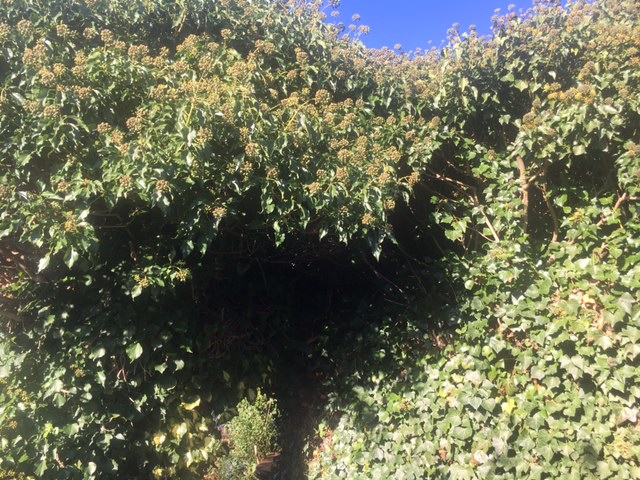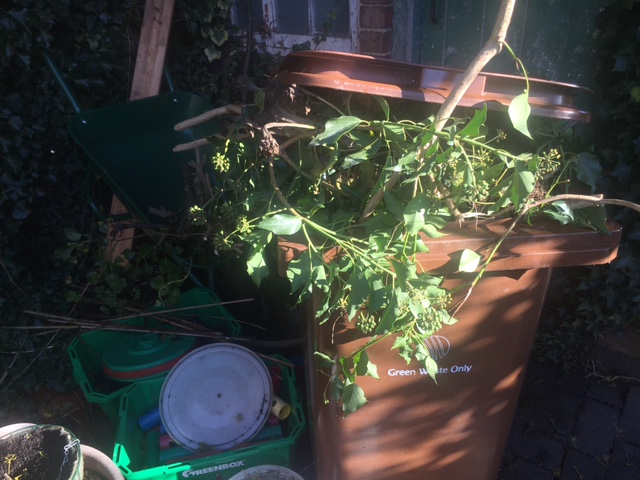
If there’s one thing that our garden has in abundance it is Ivy. This is a view, from the bathroom, of the mature Ivy covering the shed outside. Looking back from the other side of that archway looks like this (on a sunny day last week);

And there is plenty more at the end of the garden and on bits of fence on either side of our strip.
Ivy seems great for insects and when the sun shines even now it is buzzing with flies, the occasional late wasp and the last two butterflies I’ve seen in the garden were on the Ivy too (Brimstone on Friday 13 November and Red Admiral 30 October). In the spring, Holly Blues shimmer over our ivy fields.
But even I think there is a limit and we need to recreate more unshaded areas for ourselves and for some other plants, so I’ve been cutting back Ivy in a few places. It’s the perfect job for me – unskilled (I can identify Ivy pretty well) and a short period of time delivers a literally visible impact on the scale of the task.
Tomorrow is garden waste recycling day and I have a brown bin full of Ivy ready to be emptied so that I can start again on fine days.

My very rough calculation is that this bin full of Ivy represents only 2.5% of our garden Ivy standing crop and even with, at most, another two or three bins full over the autumn it won’t be making much difference overall (and this is the biggest Ivy trimming I’ve done for over a decade). So I’m not sure why the male Brimstone that flew past me (before I started work on this on Friday) while I had the secateurs and saw in hand shot me such a disapproving glance – there’s got to be some give and take in my garden! These insect ivy-activists think they can push we landowners around!
Previous Ivy-related posts: A question of Ivy, 1 October 2014; September Ivy, 28 September 2017, Isolation and Ivy by Nick Ballard, 28 April 2020; Jane V. Adams – Hunting for Ivy Bees, 26 September 2020.
[registration_form]
Ivy is a delight, a wonder. As we walk to the village shop to get the paper we pass many stone walls draped with ivy, still flowering and attracting a host of insects, mainly wasps and hoverflies and earlier, the delightful Ivy bees. Apart from some odd looks from passers-by confused as why we are photographing an ivy-clad wall and (even more concernedly) wearing binoculars round the neck, it can be a conversation starter and a quick hunt for the face-mask.
Our fifty foot Beech tree in the garden now has Ivy up to 3/5ths of it’s height.
I love seeing ivy too. People who get anxious at the sight of a tree apparently smothered by it should take a deep breath then look at the branches still not covered in case they’re worried about any species that need access to bark losing out. Even if you see a series of trees covered by ivy the antidote is to look around and you’ll usually find more trees with hardly any and frequently none, ivy is not a triffid. Some people like winding themselves into a bit of a state of righteous indignation over something and highly conspicuous ivy ‘smothering’ trees fits that bill. I’d love to see more trees and far, far more walls with ivy. The only time I do get concerned is when ivy has displaced ground flora which happens – a few boar rooting about would soon restore a bit more ground flora diversity. Ivy can increase the wind profile of a tree and increase the chances it’ll come down in high winds (I saw this happen to one branch of a young willow, while the other ivy free branch didn’t snap), but even then it creates habitat for wildlife. It should definitely get planted out too in community tree planting events.
I remember a walk on the Ridgeway LDP up from Wallingford towards Watlington. It was pretty quiet, until I came to a gateway next to a tree covered in ivy. Then the buzz from the various insects, mainly flies I think, enjoying it was a startling change but then as I walked on the sound retreated behind me and the silence returned. It was the standout moment of that particular walk
Hope that bin gets eptied.. here in Cambridge any ‘crocodile-top’ bin would be rejected and you get the little note of shame.. our lids have to be shut, It is almost as satisfying to see how heavily I can compact the ivy when trimming… ours is due a trim… we have a long hedge of it and we hack it back on a 3-year rotation so there is always a decent extent flowering and dense for wildlife hibernating and nesting
Louise – it’s thoroughly squidged down now. Thanks for introducing me to ‘crocodile-top’ !!
I have looked after an ivy hedge for 30 years. I do not know how long it was there before that. . If you have a fence, plant some berries at the base, though the birds usually do that anyway. Its great advantage is that when it reaches the top, it stops growing upward and flowers. It grows out very little. Put in some long lasting uprights, iron or concrete, and just wire (with tensioners) between them. The ivy will grow up the wood fence then when that rots you have an ivy hedge. This was happening to my elderly neighbour’s front fence, but a new broom arrived and desertified the garden and put in a nice sterile picket fence.
The ivy hege is in fact my other neighbours. The new owner thinks trees should not have ivy growing up them so that has come down. I guess the big ash it was growing up will soon follow so I am philosophical. . I do not know how long the ivy hedge will be allowed to last but it has been squared up and still flowers. With casual pruning it had a rounded, bucolic outline befitting its country location and age.
If you think ivy is dull green you also have the option of golden or white varigated ivy cultivars which flower just as well and attract insects.
So much prejudice against ivy out there. ‘It strangles trees’ etc.
If you had cut the ivy up small you could have left it to rot down nicely and feed the earth, and no fossil fuels would have been used to get rid of it.
I do think ivy makes a particularly rich compost, mulches away surprisingly quickly and of course creates one further dimension in garden diversity as it does so… do try it!
Arne – that is allegedly what happens to the green garden waste i put in the bin, presumably more eficiently than I would do it.
Hedges all over South Wiltshire and West Hampshire are being decimated by ivy. Where hedges are no longer needed to be stock-proof they are often neglected to the extent that elder and field maple become smothered by ivy and felled by a combination of snow and wind-throw. It’s very noticeable along the road from Sutton Scotney to Micheldever. Someone will decide they have become pointless linear litter disposal sites and drag them all out & put up a nice post and wire fence – I can see it now.
Close to Home it’s a case of The Ivy Wars. I had some nice flowering ivy growing up an elder behind the house. Now there is no elder and no ivy. I had a magnificent lilac tree festooned with lichen and ivy but now there is no lilac or lichen or ivy. The stump may produce a new bush if we’re lucky and maybe I’ll live long enough to see and smell some lilac again.
I’m slowly clearing the second of two field maples felled by ivy outside the garden. It’s slow going because the ivy trunks have completely encircled the maple and it takes an age for my arthritic hands to clean it off. The only bonus is free firewood that dries quite quickly, and the Old Git’s Beard lianas that get pulled down and can be dried and logged for kindling. Old ash trees in the copse are completely smothered in ivy apart from the enfeebled shoots that have now got ash dieback. I’m hoping for some casualties so that we can have some ash green or ash brown fit for a queen with a golden crown. For some reason I don’t find ivy on hazels.
I’ve decided that only ivy growing on masonry or deer fencing or outwith the garden will be allowed to remain but the back of the house has cob walls and ivy grows up them at light-speed and needs removing frequently to stop it growing into the thatch and providing rat-ladders and although I don’t particularly like them or their sticky mucilaginous berries the two very ancient yews in the garden are too important to lose so it’s crowbar and pruning saw time very soon.
“Tomorrow is garden waste recycling day and I have a brown bin full of Ivy ready to be emptied so that I can start again on fine days.”
I’m remote enough from the roadside to not have the benefit of such collections (although I do remember having the benefit elsewhere). The big trucks just can’t get to us. We even have to store any glass and deliver it to a recycling point ourselves (as collection isn’t done).
Shred and compost for us.
P.S. Shredded stuff fills garden recycling bins more effectively and thus helps prevent BLG (bin lid gape) and resultant Notes of Shame. Shredded stuff can also be compressed more effectively, thus increasing the density of bin contents.
Shredding costs elecatricity and in the case of ivy takes a long time to fiddle through my particular shredder but I’m with you in principle on shred and compost. Same with collection. Thing is, they can get to us, just like the oil man and the septic tank chap – but it’s half a mile up a flinty track and they have to do a three-point turn at a T-junction and they just can’t be arsed. There’s no street lighting as there’s no street. What we pay £2K a year for I’m not sure. Perhaps it’s for the adhesive labels we now have to stick on the black bags so they can open them and inspect them for the wrong-eyed rubbish. I feel another email to Councillr ****** coming on.